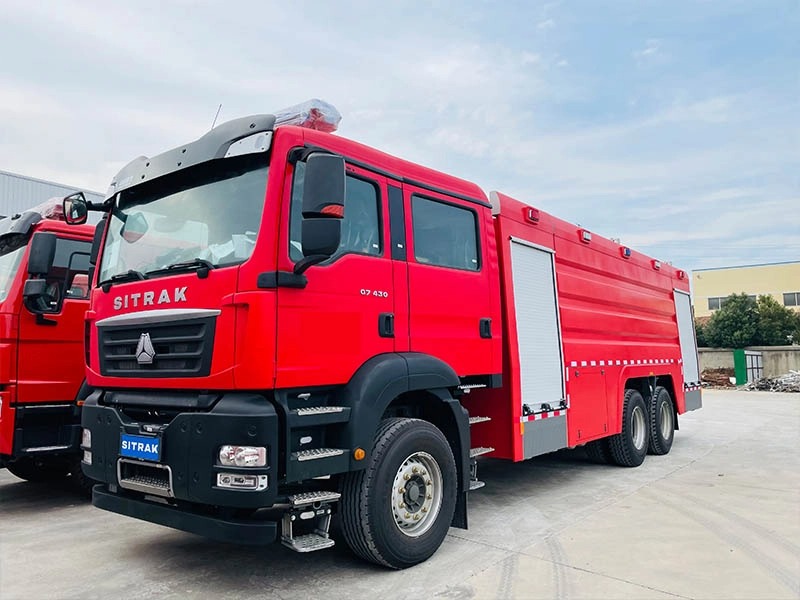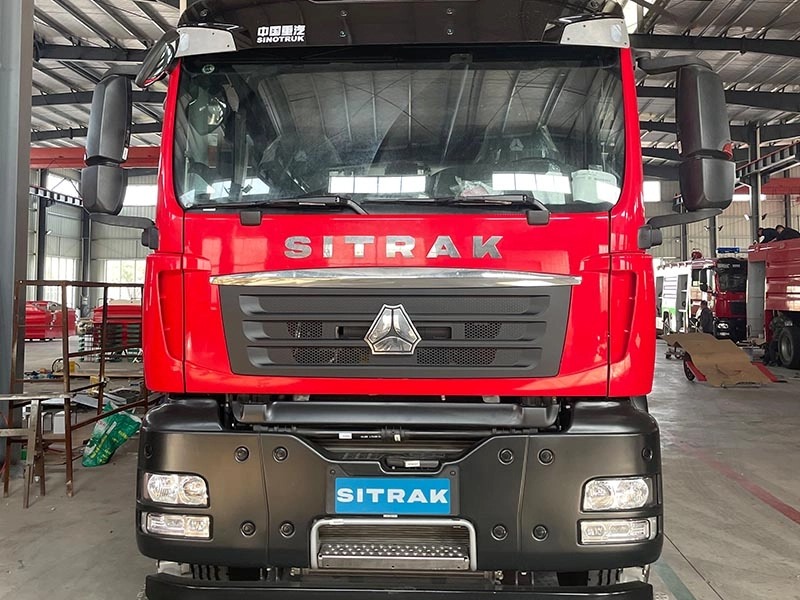Introduction
Foam fire trucks are specialized firefighting vehicles designed for high-risk environments where flammable liquids pose the greatest danger—airports, petrochemical plants, and fuel depots. These vehicles combine water and foam concentrate systems to generate a foam blanket that suppresses vapors, cools burning fuels, and prevents reignition. However, firefighting needs often change. Departments sometimes question whether their foam fire truck can operate effectively using only water. Converting such a specialized apparatus into a water-only role is not a straightforward decision; it involves assessing mechanical compatibility, system modifications, operational impact, and maintenance demands. Understanding these factors is critical for ensuring both performance and safety.
Understanding the Design and Function of a Foam Fire Truck
A foam fire truck (also known as an ARFF – Aircraft Rescue and Firefighting vehicle – or foam tender) integrates both water and foam concentrate tanks connected through proportioning systems. The foam proportioner mixes concentrate and water to produce firefighting foam, typically in concentrations ranging from 1% to 6%.
The key components include:
| Component | Primary Function | Compatibility with Water-Only Use |
| Foam Tank | Stores foam concentrate | May need flushing or bypassing |
| Proportioner | Mixes foam concentrate with water | Often requires calibration or disconnection |
| Pump | Moves water/foam through the system | Typically water-compatible |
| Nozzles | Expel foam solution or water | Usually adjustable for both roles |
The engineering behind these systems is precise. Foam proportioners, valves, and pumps are built for foam concentrate’s viscosity and chemical properties. Switching to water-only operation could simplify logistics but may also change the vehicle’s flow dynamics and pressure requirements.
Why Convert a Foam Fire Truck to a Water-Only Role?
Several practical and economic reasons drive this question. Foam systems, while essential in specific environments, require continuous maintenance, specialized training, and costly foam concentrates. When departments move away from flammable liquid hazards—such as after facility closure or reassignment to structural fire zones—maintaining foam capability may become unnecessary.
Key motivations for conversion:
Cost reduction: Foam concentrates, especially fluorine-free options, are expensive and have limited shelf life.
Simplified operations: Water-only systems require less maintenance and fewer calibration checks.
Environmental regulations: New laws restrict PFAS-based foams, prompting departments to retire or repurpose older foam units.
Adaptability: Converting allows older foam trucks to serve in rural or municipal firefighting operations.
In essence, converting a foam fire truck to water-only mode can extend its service life and align with modern sustainability goals—if executed correctly.

Technical Feasibility: What Modifications Are Required?
While conceptually simple, converting a foam fire truck to a water-only role involves more than just emptying the foam tank. Each subsystem must be evaluated for mechanical and chemical compatibility.
1. Foam Tank Management
Foam tanks are coated internally to resist chemical corrosion from concentrates. When converting, these tanks can be flushed and repurposed for water storage, though this may not always be efficient. Some departments cap off or isolate the foam tank completely to prevent contamination.
2. Proportioning System Adjustments
Foam proportioners—whether around-the-pump, direct injection, or balanced pressure—can restrict flow or create unwanted backpressure when dry. Many conversions involve bypassing these components or reconfiguring plumbing to create a direct water line.
3. Pump and Valve Calibration
Pumps used in foam systems typically operate at specific discharge pressures for foam application. In water-only roles, recalibration ensures adequate pressure for hose lines or monitors.
| System Component | Required Modification | Complexity Level |
| Foam tank | Flush or isolate | Low |
| Proportioner | Bypass or remove | Moderate |
| Control valves | Recalibrate for water | Moderate |
| Nozzles | Adjust pattern and flow | Low |
Each modification should follow the manufacturer’s engineering documentation to avoid impairing performance or voiding safety certifications.
Operational Implications of Using a Foam Fire Truck with Water Only
Switching to water-only operation impacts both performance and tactical flexibility. Foam systems are optimized for high-volume discharge of thick foam solution—ideal for covering flammable liquid surfaces. When these trucks operate with water alone, the extinguishing mechanism shifts from vapor suppression to cooling and smothering.
1. Performance Changes
Water stream quality: Some nozzles designed for foam aeration may produce less effective spray patterns with water only.
Flow rate adjustments: Without the foam mixture, overall flow rates may increase, requiring pump recalibration.
Cooling efficiency: Water alone cools effectively but lacks the vapor suppression benefits of foam.
2. Tactical Considerations
Water-only operation suits structural or wildland firefighting better than fuel spill or aircraft fires. Firefighters must adjust tactics, relying more on volume application and less on surface coating.
3. Crew Training
Operators familiar with foam deployment need retraining on pump pressures, discharge techniques, and nozzle management under pure water conditions.
Benefits and Drawbacks of Converting to Water-Only Operation
Every modification decision carries trade-offs. Understanding these helps fire departments evaluate if conversion aligns with their mission profile.
| Aspect | Benefits | Drawbacks |
| Cost | Eliminates foam concentrate expenses and proportioner maintenance | Potential retrofit costs |
| Maintenance | Simplifies cleaning and inspection routines | Loss of foam capability limits versatility |
| Environmental | Avoids discharge of PFAS foams | Requires proper foam disposal |
| Operational | Extends vehicle lifespan in general firefighting | Reduced effectiveness on fuel-based fires |
In many cases, departments treat the conversion as a transitional measure—keeping foam hardware intact but dormant, ready for future reactivation if needed.
Environmental and Regulatory Considerations
Environmental sustainability plays a central role in modern fire service decisions. Many legacy foam fire trucks still use Class B foams containing PFAS (per- and polyfluoroalkyl substances)—chemicals linked to environmental contamination.
1. Regulatory Pressure
Governments in North America, Europe, and Asia are banning or restricting PFAS-based foams. Agencies are mandated to phase out or retrofit their foam trucks with fluorine-free alternatives. Converting to a water-only role is often a stopgap measure to comply with these new standards without immediate capital investment in new vehicles.
2. Foam Disposal Requirements
Old foam concentrate cannot simply be drained; it must be treated as hazardous waste. Professional disposal through certified waste handlers ensures environmental compliance.
3. Sustainability Benefits
A water-only foam fire truck eliminates the risk of chemical runoff during training or operations, significantly reducing environmental impact and public liability exposure.

Maintenance and Long-Term Performance After Conversion
Once converted, the former foam system requires modified maintenance routines.
Key steps include:
System flushing: To remove residual foam concentrate and prevent corrosion or scaling.
Seal inspection: Foam chemicals can degrade seals; replacing them ensures watertight integrity.
Regular flow testing: Verify consistent water discharge pressure and nozzle performance.
Component labeling: Clearly mark inactive foam components to avoid confusion during emergencies.
These steps ensure reliability and reduce the risk of malfunction under operational stress. When properly managed, a converted foam fire truck can remain service-ready for another decade or more.
Strategic Decision-Making: When Conversion Makes Sense
Conversion is not universally ideal. The decision depends on operational requirements, available resources, and regional fire risks.
| Scenario | Conversion Suitability |
| Municipal fire service | High – water-based firefighting dominates |
| Airport or industrial plant | Low – foam remains essential |
| Rural or wildland firefighting | Moderate to high |
| Training and reserve fleets | High – cost-effective repurposing |
Departments must evaluate whether maintaining foam capability aligns with future hazard profiles. When flammable liquid incidents are rare, water-only operation may offer optimal efficiency without sacrificing readiness.
Conclusion
A foam fire truck can indeed be converted to a water-only role—but the process demands technical precision, careful planning, and regulatory awareness. By flushing foam tanks, bypassing proportioners, recalibrating pumps, and retraining crews, departments can effectively extend the life of existing vehicles while meeting modern environmental and financial goals. However, the decision must balance tactical flexibility against the loss of specialized foam suppression capability. For agencies transitioning from industrial to municipal or rural operations, water-only conversion represents a practical, sustainable evolution in firefighting strategy.
FAQ
1. Can a foam fire truck safely operate without foam concentrate?
Yes. Once the foam system is properly flushed and bypassed, the truck can safely deliver water for conventional firefighting operations.
2. Does conversion affect pump performance?
Slightly. Removing foam proportioners may alter flow dynamics, but with proper calibration, pumps function effectively for water discharge.
3. Is conversion reversible if foam capability is needed again?
In many cases, yes. If systems are left intact and properly maintained, reactivating the foam function is possible.
4. How costly is the conversion process?
Costs vary depending on system type and complexity. Simple conversions can be done in-house, while major modifications may require manufacturer support.
5. Are there legal requirements for foam removal or disposal?
Yes. PFAS-based foams are considered hazardous waste in many jurisdictions. Certified disposal ensures compliance and environmental protection.

















